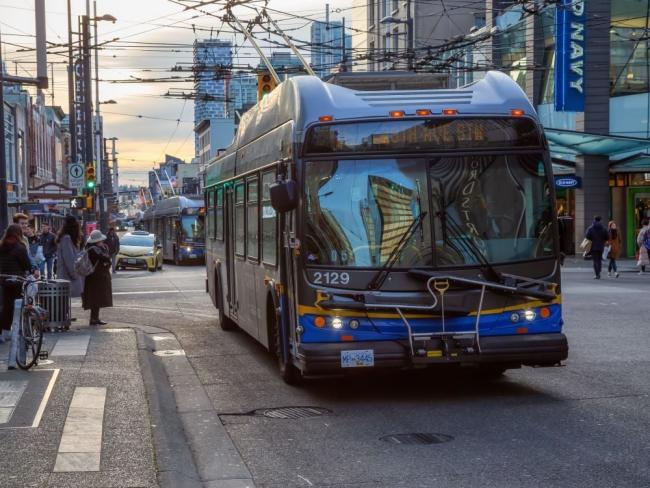Articles Menu

Sept. 17, 2024
The BC Green Party made the first big splash of the 2024 provincial election campaign with a major commitment to expand public transit, including a promise of “free public transit, provincewide” that has been widely criticized as being too costly.
While shifting to free transit for everyone, everywhere, could be fiscally and logistically challenging in the short run, B.C. needs bold solutions to address the congestion clogging up our cities, shrink our societal dependence on cars and improve affordability of transportation.
Free transit would need to be combined with major transportation investments to bolster local transit systems and interconnect them across the province, as recommended in our recent “Connecting B.C.” report.
In that report, we call for doubling the number of buses in B.C. within five years and tripling within 10 (both of which are echoed in the Green Party platform), in addition to new rail and ferry infrastructure and the expansion of free transit.
B.C. has already made transit free at certain times, such as New Year’s Eve, or for ticket holders during the 2010 Olympics. At a minimum, free transit could be expanded to include more people, including youth, seniors and low-income households. For example, the BC Bus Pass Program already exists for low-income seniors (over age 60) and some people on disability assistance and could easily include others on income assistance.
This would also bridge the gap to the U-Pass available to university and college students. Under the U-Pass, costs are paid up front in school fees and spread among all potential users, with the result being a zero marginal cost for each transit trip.
Fares in B.C. are discounted for all seniors over age 65 and some people with disabilities (HandyCard holders). Free transit could be contemplated for seniors during off-peak hours when there is abundant capacity.
In Metro Vancouver, TransLink is advocating that the B.C. government fund a low-income pass program at a cost of $60 million to $70 million per year. This is modelled on programs in Calgary and Edmonton funded by the Government of Alberta.
Such a program in B.C. would offer fare discounts to 43,000 transit users and would save low-income households thousands of dollars per year depending on the number of people and distance travelled. In Metro Vancouver, a monthly pass is $1,259 to $2,273 per year for one and three zones, respectively.
But why stop there? Some cities have taken the next step and made transit free system-wide or in the downtown core.
After free transit was introduced in Kansas City, Missouri, in 2019, it led to mobility and transit benefits for riders and increased safety for drivers, and had much faster recovery of ridership from COVID-19 than other transit systems. Alexandria, Virginia, made transit free in 2021 and has set new ridership records. In 2022 Montreal made transit free on weekends downtown, and in Luxembourg all forms of transit have been free since March 2020.
A historical concern with free transit is that too many people would use it, overwhelming services. But this is precisely what we want: a major shift of people onto transit would contribute to meeting B.C.’s greenhouse gas emission reduction targets.
The key challenge is cost and the current fiscal environment for TransLink and BC Transit. Free transit would require substantial operating subsidies from the B.C. government and would compete with service expansion.
Based on current transit fare collection, free transit would require a provincial subsidy of only $750 million per year. However, a model of free transit plus major transit service expansion would require several billion dollars per year of public support.
Current expenditures by households and governments on automobile-dominated transportation are also massive. British Columbians spent over $10 billion on new vehicles in 2022 and about the same on gasoline.
Substantial public costs exist for building and maintaining roads, for bridges, policing and related services and providing parking spaces. Free transit would be not so much a new cost to society but a reallocation of existing private spending on transportation.
Indeed, all transportation is subsidized. It’s just that drivers typically don’t appreciate by how much. For example, in the 2023 B.C. budget, fuel taxes will raise $1 billion in 2023-24, but the government will spend more than $3 billion for operating and capital expenditures for car- and truck-oriented highway infrastructure.
Moreover, driving imposes other costs on society, including greenhouse gas emissions and environmental costs of raw materials, as well as congestion, noise and public space for parking. These external costs can account for about 35 per cent of the total cost of driving, according to a review of transportation costs in North American cities.
Every additional car on the road adds to these problems.
Public transit is essentially the opposite: more people using transit reduces the number of cars on the road, benefiting drivers and freight transport. As B.C.’s population grows and we need to drive down greenhouse gas emissions, a major shift to public transit is needed.
Free transit could be the ticket to making that shift.
[Top photo: ‘Free transit would be not so much a new cost to society but a reallocation of existing private spending on transportation,’ CCPA-BC senior economist Marc Lee writes. Photo via Shutterstock.]